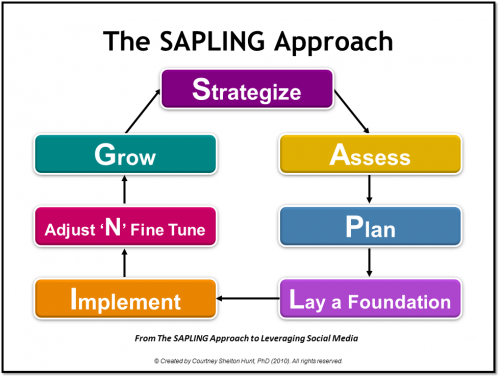Not content to focus on the benefits that social and digital engagement can bring, some advocates like to issue warnings about the inevitable demise of organizations that don’t jump on the social and digital bandwagons. Succumbing to that pressure, or perhaps feeling compelled by the bandwagon effect itself, leaders have gradually become interested in adding various forms of social and digital engagement to their corporate priorities to ensure they don’t miss out.
Although they may have decided to explore technology’s potential, many leaders pursuing social and digital engagement initiatives are understandably tempted to outsource or delegate the responsibility for these initiatives. Reasons for this temptation include the following:
- They are already extremely busy pursuing a host of other priorities and feel unable to add one more thing to their jam-packed To Do lists.
- They have limited familiarity with social and digital technologies themselves and have barely begun to climb their own learning curves. Consequently, they may not feel qualified to assume a direct leadership role.
- Their lack of familiarity may also contribute to the perspective that social and digital technology initiatives are independent, add-on projects rather than efforts that should be integrated into the pursuit of the organization’s mission and priorities.
- Because there are low barriers to accessing and using many social and digital platforms and tools, as well as a seemingly low financial commitment, they may underestimate the strategic complexity of leveraging them effectively.
- Underestimating the strategic complexity of social and digital technologies can cause leaders to assume the necessary approaches are primarily tactical, an assumption that is reinforced by the widespread emphasis on specific activities such as blogging and tweeting. Consequently, they may conclude these activities can be carved out and handled by someone who’s not engaged in core organizational functions.
- There’s no shortage of “hire me!” social and digital technology service providers who reinforce the idea that these activities can easily be outsourced and still produce great results.
Obviously, leaders can’t get involved in the detailed aspects of their organization’s social and digital technology efforts. But given how high the stakes involved with social and digital engagement are, in terms of both risks and rewards, it’s incumbent upon them – and in their organization’s best interests – to make it a personal priority.
Here are my recommendations for what leaders should do to provide the necessary leadership in their organizations, not just in the short term, but over the long haul.
Educate Themselves so They Can Better Leverage the Expertise of Others
Because of the potential of social and digital technologies to significantly change how organizations function, both externally and internally, leaders must educate themselves about these technologies, as well as their applications and implications. Doing so will enable them to make the best possible decisions about how to move forward and provide the strategic guidance their organizations and other stakeholders need, in addition to properly allocating financial and other resources (especially human capital).
That’s not to say that leaders should not use or rely on social and digital technology experts – far from it. Especially in the early stages, it doesn’t make sense for leaders to try to invest the time and attention necessary to develop in-depth knowledge and expertise. But leaders need to understand and accept that it’s their mountain to climb. Social and digital technology experts can serve as Sherpas, but the leaders are in charge of the expedition and need to develop the big-picture perspective necessary for that role.
(click here to read more about the value of social media experts)
Develop a Strategic, Integrated Approach to Leveraging Social and Digital Technologies
After they begin to develop a high-level understanding, the next step is to assess the strategic value of social and digital technologies and engagement. Organizational leaders need to identify their strategic goals and objectives and then explore IF and HOW social and digital technologies can help achieve them. They need to unpack ideas like “we want more customers” to identify in more specific terms what those ideas mean in the context of factors such as the organization’s mission, its core values, key stakeholders, and the competitive environment in which it operates. That information, coupled with a strong understanding of social and digital technologies, can enable leaders to identify which platforms, tools and applications, if any, could enhance performance and maximize results.
Given that we’re still in the early stages of the social and digital (r)evolution, many leaders may conclude as a result of this assessment that they can continue to be successful without leveraging these technologies (yet). That’s a perfectly acceptable conclusion. Though social and digital technologies can in theory improve every kind of operation, in reality it may not be necessary or practical for some of them. Lots of individuals still get along quite nicely with paper rolodexes, rotary phones and no computers, and there are plenty of successful organizations that don’t even have websites yet, let alone something more sophisticated. Though they may be technological dinosaurs, they’re a long way away from becoming completely extinct.
Deciding “not now” or “not yet” should not be viewed as permanent, however. Leaders must periodically revisit the issue to determine when becoming more socially and digitally engaged will be in their organization’s best interests.
(click here to learn about the SAPLING Appraoch to Leveraging Social Media)
When leaders conclude that leveraging social and digital technologies has strategic value, they need to determine the best way to proceed. Though it may be tempting to think in terms of tactics (e.g., blogging or creating a Twitter account), a collection of tactics does not constitute a strategy. Building on the results of the strategic assessment, organizational leaders need to guide the development of a plan that best matches their operating characteristics. There is no “one-size-fits-all” approach.
Because they are best viewed as a means to an end rather than an end in and of themselves, it’s best to integrate social and digital technologies into other organizational projects and activities rather than treating them as stand-alone initiatives.The approaches developed must respect the underlying complexity of social and digital technologies, however. The ideas and principles behind these technologies may be pretty straightforward, and many of the platforms and tools are intuitive and user friendly, but simple doesn’t mean easy. As many organizations have found out – the hard way – doing things right is a lot more challenging than it may at first appear. It is not in an organization’s long-term best interests to underestimate the challenges involved in leveraging social and digital technologies.
Allocate Resources to Maximize Effectiveness and Reduce Risk
The organization’s strategy and approaches to social and digital technologies will drive decisions about how to allocate resources to various initiatives. As discussed in this post, for many organizations the financial commitment to pursue these initiatives will not be significant; however, the time commitment cannot be underestimated. Capacity matters a lot. The engines of social and digital engagement are fueled by the time, effort, and expertise of human beings. Even in an era of trying to do more with less, organizations need to allocate human resources to technology initiatives and give them the space and support they need to be successful. There are no shortcuts here.
In deciding how to allocate human resources, it’s tempting for leaders to assign social media responsibilities in particular to junior staffers, for a couple of reasons. Because the leaders themselves are unfamiliar with social media, they may think it takes a unique set of skills that come naturally to “digital natives” and may be assumed to be too challenging for “digital immigrants” to learn quickly. In addition, because of the tendency to overemphasize tactics and underestimate strategy, they may be operating under the mistaken belief that these activities aren’t important enough to merit the time and attention of more senior staff. In other words, there’s a tendency to assume that the technology trumps the content. The truth is, however, that content expertise is much more important to social media success than technological expertise. When viewed as being integrated into an organization’s strategic priorities, it’s clear that the people assuming the most significant social and digital engagement roles should be those who best understand the organization and its priorities, stakeholders and operating environment.
This does not mean that leaders should not delegate or outsource any social and digital engagement activities, but they need to be smart about how they leverage the resources available to them to achieve their goals. As with other aspects of organizational operations, those activities that are most closely connected to the organization’s core functioning should probably remain in-house, and the more closely connected an activity is with the organization’s mission, the more senior folks should be involved.
(click here to learn more about governance and other building blocks of Digital Era success)
Make a Personal Commitment
Once leaders have decided that social and digital engagement is a strategic imperative, they must identify what their own role will be and should make the necessary commitment to be successful in that role. At a minimum they have to assume personal responsibility for being connected to the organization’s social and digital engagement efforts, both externally and internally. If the organization has Twitter accounts, for example, the leaders should follow them. If there are internal blogs, they should subscribe to and read as many of the most relevant ones as possible.
In many cases, it may be appropriate for leaders to assume a more active role, most notably through blogging and tweeting themselves, as well as posting and responding to items on internal social networks. This can’t be nominal engagement, however. Whenever possible, leaders should assume this responsibility directly rather than allowing someone to “ghost-post” for them. The need to express the leadership perspective using a genuine voice is more critical in the Digital Era than ever before. Leadership communications are now driven by informal conversation and collaboration rather than the issuance of formal pronouncements and edicts. For more information along these lines, check out BRANDfog’s 2014 Global Social CEO Survey.
To enable a personal commitment to social engagement, leaders must make the time to learn and use various social media tools. They can’t wait to find the time, because that’s never going to happen. Most of us don’t have enough excess capacity to add new activities without giving up old ones. That means organizational leaders may need to reexamine the things they’re currently spending time on to decide which of their less productive activities they should give up to make way for potentially more valuable social media efforts.
Your Thoughts?
As always, I welcome your feedback. What would you add to, change, or delete from the recommendations above? What other leadership aspects are critical to effective social and digital engagement?







Leave a Reply
You must be logged in to post a comment.